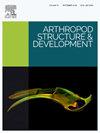Sexual dimorphism and ultrastructure of salivary glands in adult Bittacus cirratus Tjeder, 1956 (Mecoptera: Bittacidae)
IF 1.3
3区 农林科学
Q2 ENTOMOLOGY
引用次数: 0
Abstract
Sexual dimorphism is ubiquitous in insects and has been extensively studied across various taxa. However, it remains unclear whether the salivary glands exhibit sexual dimorphism in adult Bittacidae. In this study, a comparative study of salivary glands in adult male and female Bittacus cirratus Tjeder, 1956 was performed using light and transmission electron microscopy. The salivary glands are tubular labial glands in both sexes of B. cirratus, consisting of a salivary pump, a common salivary duct, a pair of efferent ducts, and numerous dichotomously branching secretory tubules. Interestingly, the salivary glands in females contain a pair of small salivary reservoirs, which are not present in the males. The male salivary glands have a significantly larger diameter and more secretory tubules than those in females. In contrast, male secretory cells occupy a minimal volume of the secretory tubule, resulting in a larger secretory lumen that nearly fills the entire tubule. This configuration enhances the storage capacity of the male secretory tubules. Male secretory cells exhibit active autophagy, possibly due to their approaching late life stages. Sexual dimorphism in the salivary glands and the possible reasons are briefly discussed in Bittacidae.
猕猴桃成虫唾液腺的两性异形及超微结构(鞘翅目:猕猴桃科)
两性二形现象在昆虫中普遍存在,并在不同的分类群中得到了广泛的研究。然而,尚不清楚成年双尾蚊的唾液腺是否表现出性别二态性。本研究采用光镜和透射电镜对1956年成年雄性和雌性圆鼻Bittacus cirratus Tjeder的唾液腺进行了比较研究。唾液腺为管状唇腺,由一个唾液泵、一个共同的唾液管、一对输出管和许多二分叉的分泌小管组成。有趣的是,雌性的唾液腺含有一对小的唾液腺库,这在雄性中是不存在的。雄性的唾液腺直径明显大于雌性,分泌小管也明显多于雌性。相比之下,男性分泌细胞占据分泌小管的最小体积,导致分泌腔更大,几乎填满整个小管。这种结构增强了男性分泌小管的储存能力。男性分泌细胞表现出活跃的自噬,可能是由于它们接近生命晚期。本文简要讨论了舌蚊科中唾液腺的两性二态性及其可能的原因。
本文章由计算机程序翻译,如有差异,请以英文原文为准。
求助全文
约1分钟内获得全文
求助全文
来源期刊
CiteScore
3.50
自引率
10.00%
发文量
54
审稿时长
60 days
期刊介绍:
Arthropod Structure & Development is a Journal of Arthropod Structural Biology, Development, and Functional Morphology; it considers manuscripts that deal with micro- and neuroanatomy, development, biomechanics, organogenesis in particular under comparative and evolutionary aspects but not merely taxonomic papers. The aim of the journal is to publish papers in the areas of functional and comparative anatomy and development, with an emphasis on the role of cellular organization in organ function. The journal will also publish papers on organogenisis, embryonic and postembryonic development, and organ or tissue regeneration and repair. Manuscripts dealing with comparative and evolutionary aspects of microanatomy and development are encouraged.

 求助内容:
求助内容: 应助结果提醒方式:
应助结果提醒方式:


